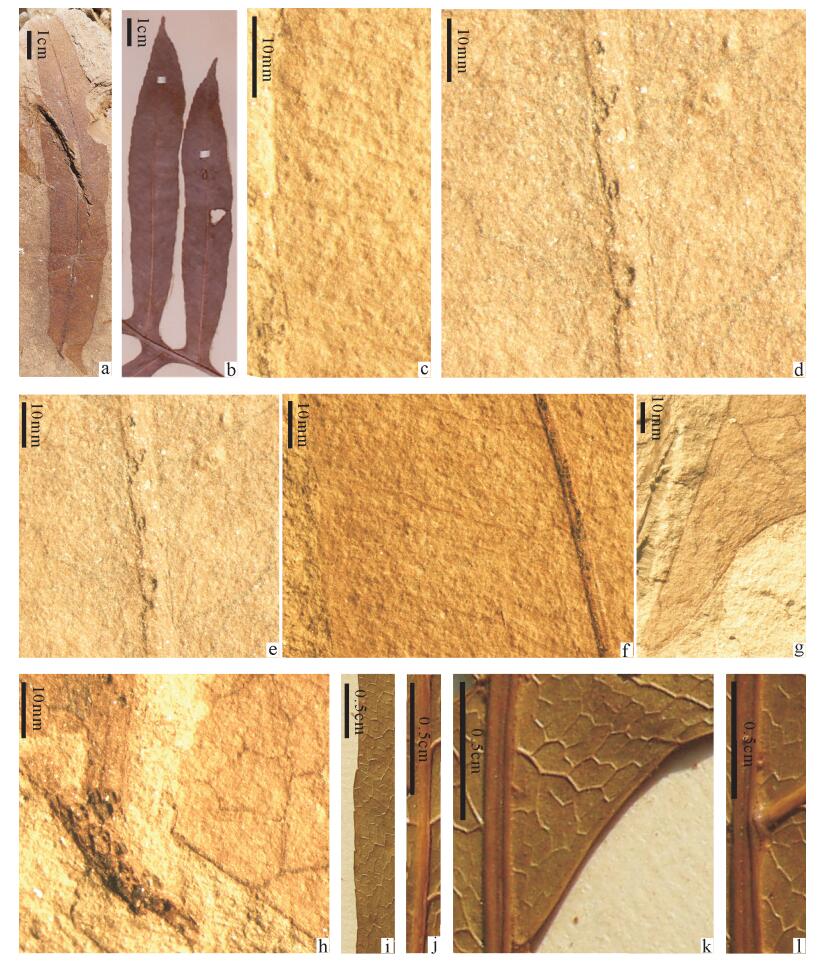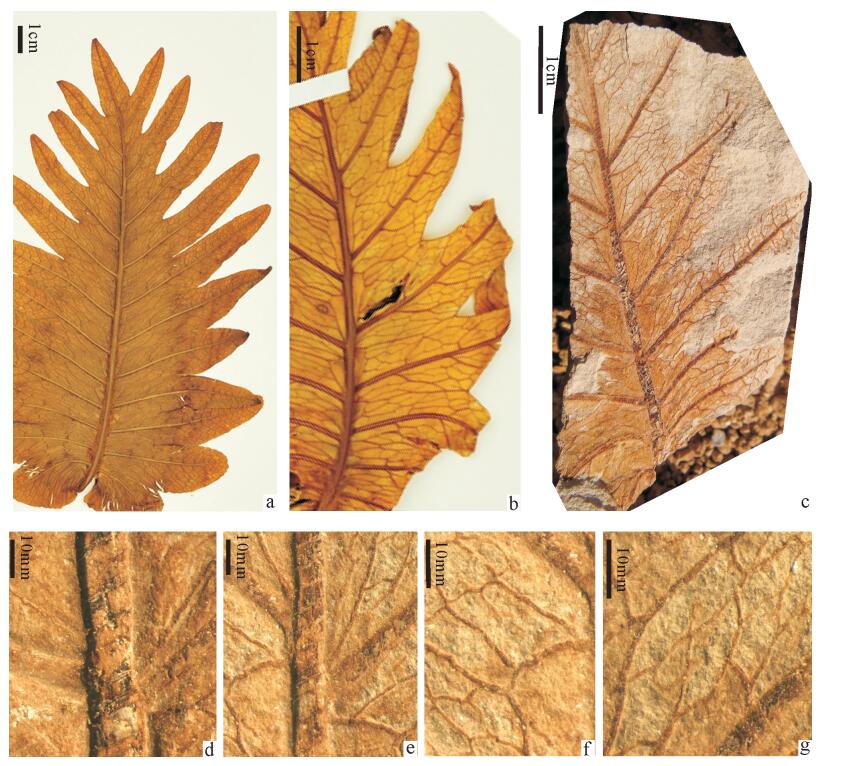Revision on a fossil species of Late Miocene polypodiaceae from Lin-cang, Yunnan Province, and its biological significance
-
摘要:
云南现代真蕨类植物资源丰富,蕨类植物多样性的地史起源,必须从化石记录入手。在云南临沧上中新统邦卖组植物化石采集中发现了槲蕨属1块不育叶和2块腐殖叶的新材料,这些标本为修订Drynaria propinqua Wen et al.,2013,以及揭示该种不育叶和腐殖叶的特征提供了新的材料。通过与槲蕨属国内外报道的化石种和现生种的详细比较,将其重新定名为Drynaria cf.propinqua。Drynaria cf.propinqua的发现,表明云南临沧晚中新世的气候与现今中国西南地区温暖湿润的气候类似,这些附生植物的生活习性表明,临沧地区复杂分层的森林生态系统至少在晚中新世已经确立。
Abstract:Yunnan Province is rich in resources of modern ferns. Understanding the origin and the diversity history of Yunnan ferns must learn from fossil records. Some new materials including one sterile frond and two humus fronds of the genus Drynaria were found in recent collections. These new specimens allow us to revise the previous fossil species Drynaria propinqua Wen et al., 2013, and provide supplementary characteristics of sterile and humus fronds for this species. On the basis of detailed morphological compari-son of fossils with extant species of Drynaria, the authors identified this species as Drynariacf. propinqua. The occurrence of Drynariacf. propinqua indicates that the Late Miocene climate of Lincang in Yunnan was similar to that of Southwest China today, being warm and humid. The epiphytic habit of its extant relative species implies that the complex hierarchical forest ecosystem of Lincang in Yunnan had been established at least in Late Miocene.
-
Keywords:
- Lincang /
- Late Miocene /
- Polypodiaceae /
- Drynaria /
- ecosystem
-
致谢: 感谢兰州大学李宏、王磊、温雯雯、邵洋、王云峰、李斌科硕士研究生在野外化石采集中给予帮助,感谢王雪莲在实验和拍照过程中的指导与帮助。
-
图 1 化石采集点位置[12]
Figure 1. Fossil locality of Lincang in Yunnan Province
表 1 槲蕨属不育叶化石与现生种对比
Table 1 Comparison of sterile frond between fossilDrynaria cf.propinqua and other fossils and extant species of Drynaria
种类 边缘 叶形 主脉 二级脉 三级脉 网眼状结构 叶长/cm 叶宽/cm 基部形状 叶的顶端形状 来源 化石种 D. callispora 全缘 卵圆形-椭圆形 明显,直 直或之字形 可见 存在,呈不规则或四边形 3.5~3.87 1.17~1.51 下延、收缩 急尖或钝 [4] D. dimorpha 锯齿 贝壳状 明显 之字形、未达缘 可见 存在,呈不规则或四边形 保存部分10~15.8 7.5~12.8 下延、明显收缩 急尖或钝 [5] D. cf. propinqua 锯齿 椭圆倒披针形 明显 可见、上攀式弯曲、纤细,直或之字形、未达缘或达缘 可见 存在,线性自由小脉,以五边形为主 保存部分10~11 1.5~1.9 下延 NA 本文;[6] 现生种 D. propinqua 锯齿 三角形-卵形 明显 明显,直,未达缘 可见 存在 (20-)30~50(-60) (12-)20~30 NA 尖头 [1,20] D. roosii 不明显的疏钝齿 披针状 明显 明显,之字形 可见 存在 20~45 10~15(-20) 心形 急尖或钝 [1,20] D. quercifolia 锯齿 长圆形 明显 明显,直 可见 存在,无内藏小脉 40~100 40 心形 渐尖 [1,20] D. rigidula 圆齿状-锯齿状 卵形 突起 突起,直 明显 突出,显著,网眼小、不整齐 25~100(-200) 12~50 渐狭而呈楔形 渐尖 [1,20] D. mollis 全缘 椭圆形 突起 突起 明显 突出,显著 20~40(-50) 7~12(-15) 心脏形 圆钝 [1,20] D. parishii 近全缘或略折皱 三角形 向下突起 明显,直 可见 存在,相邻两侧脉间有3~5行网眼,有内藏分离小脉 25 20 NA 尖头或渐尖头 [1,20] D. sparsisora 全缘 四角形-卵圆形 NA 直 NA NA NA NA NA NA [22] D. willdenowii 锯齿 四角形-卵圆形 突起,明显 直 可见 存在,明显 NA NA NA NA [22] D. laurentii 锯齿 四角形-卵圆形 NA 直 NA NA NA NA NA NA [22] D. descensa 全缘 四角形-卵圆形 NA 明显,之字形 NA NA NA NA NA NA [22] D. pleuridioides 全缘 四角形-卵圆形 可见,明显 之字形 可见 NA NA NA NA NA [22] D. involuta 全缘 四角形 突起,明显 明显,直 可见 存在,明显 NA NA NA NA [22] D. volkensii 锯齿 四角形-卵圆形 突起,明显 之字形 可见 存在,明显 NA NA NA NA [22] D. delavayi 浅缺刻 卵圆形-椭圆形 突起 突起,之字形 明显 突出、显著,大都有内藏小脉 25~45 12~18 耳形 尖头 [1,20,23] D. bonii 近全缘-浅波状 长圆状卵形 明显,粗细程度一般 明显,之字形,纤细,达缘 可见 存在,横脉明显,在每对侧脉之间构成5~6个大网眼,大网眼内有几个不整齐的小网眼,内藏小脉单一或很少分叉 30~70 20~30 稍狭长而下延 钝头至长渐尖 [1,20,24] D. baronii 锯齿状 狭长圆形 NA NA 可见 清晰,大都有内藏小脉 22~50 7~12 阔卵形 尖头或钝头 [1,20,25] 注:NA—不可用 表 2 槲蕨属腐殖叶化石与现生种对比
Table 2 Comparison of humus fronds between fossil Drynaria cf. propinqua and other fossils and extant species of Drynaria
种类 边缘 叶形 主脉 二级脉 三级脉 网眼状结构 叶长/cm 叶宽/cm 基部形状 叶的顶端形状 来源 化石种 D. cf. propinqua NA NA 粗壮 明显,粗 可见,之字形 存在,以五边形为主、线性的自由小脉 NA NA NA NA 本文 现生种 D. propinqua 不规则齿状 圆形或卵圆形 明显 明显 NA NA 10~20 7~18 NA 圆钝或尖头 [1,20] D. bonii 全缘或有圆形的浅裂 卵圆形-椭圆形 明显,粗壮 明显,粗 明显 存在,小脉下面明显而隆起,联结成伸长的网眼,少数有单一的内藏短小脉 (4-)10~15 (3.5-)8~12 浅心脏形而有互相覆盖的耳 钝或圆 [1,20] D. delavayi 略成齿状 卵圆形-椭圆形 明显 明显 NA NA 6~13 4~10 耳状 NA [1,20] D. mollis 全缘 椭圆形 明显 明显 明显 存在,叶轴两侧有明显的1行大网眼 7~15 3~7 心脏形,两侧有相互覆盖的耳 钝或尖头 [1,20] D. quercifolia 浅裂-深裂, 叶顶全缘 卵形 NA 粗壮,上部的斜向上,中部的平展,下部的向下反折成弧形 可见 存在,侧脉之间有曲折而不明晰的横脉相连,小脉连结成伸长的网眼,一般无内藏小脉 15~50 10~30 心脏形而有耳 钝圆 [1,20] D. roosii 全缘 心形 NA NA NA NA (2-)5~9 (2-)3~7 NA NA [1,20] D. rigidula 不规则细微齿状 长卵形 明显 明显 NA NA 10~30 5~15 心脏形而有耳 尖头-锐尖头 [1,20] D. baronii 略成齿状 椭圆形 NA NA NA NA 3~15 3~6 狭窄的,不是心形也不是耳状 NA [1,20] 注:NA—不可用 -
Wu Z Y, Raven P H, Hong D Y. Flora of China, Volume 2-3, Ly-copodiaceae through Polyodiaceae[M]. Beijing:Science Press, 2013:766-768.
Anderson J A R, Muller J. Palynological study of a Holocene peat and a Miocene coal deposit from NW Borneo[J]. Review of Palaeo-botany and Palynology, 1975, 19:291-351. doi: 10.1016/0034-6667(75)90049-4
Zhou Z K, Xia Y J, Liu W L, et al. Reconstruction of paleovegeta-tion and paleoclimate of Holocene hypsithermal in the Hemudu re-gion[J]. Chinese Geographical Science, 1995, 5:232-241. doi: 10.1007/BF02665579
Su T, Jacques F M B, Liu Y S, et al. A new Drynaria (Polypodiace-ae) from the Upper Pliocene of Southwest China[J]. Review of Pal-aeobotany and Palynology, 2011, 164:132-142. doi: 10.1016/j.revpalbo.2010.11.011
Wu J Y, Sun B N, Xie S P, et al.Dimorphic fronds and in situ spores of Drynaria (Polypodiaceae) from the upper Pliocene of Southwest China[J]. Review of Palaeobotany and Palynology, 2012, 72:1-9. http://www.sciencedirect.com/science/article/pii/S0034666712000085
Wen W W, Xie S P, Liu K N, et al. Two species of fern macrofossil from the late Miocene of Lincang, Yunnan, China and their paleo-ecological implications[J]. Palaeoworld, 2013, 22(3):144-152. http://www.sciencedirect.com/science/article/pii/S1871174X13000267
Hu R Z, Qi H W, Zhou M F, et al. Geological and geochemical constraints on the origin of the giant Lincang coal seam-hosted ger-manium desposit, Yunnan, S W China:A review[J]. Ore Geology Reviews, 2009, 36:221-234. doi: 10.1016/j.oregeorev.2009.02.007
陶君容, 周浙昆, 刘裕生.中国晚白垩世至新生代植物区系发展演变[M].北京:科学出版社, 2000:49-290. 陶君容, 陈明洪. 横断山南部: 云南临沧地区新生代植物群[C]//中国科学院青藏高原综合科学考察队. 横断山考察专辑(一). 昆明: 云南人民出版社, 1983: 74-89. 戈宏儒, 李代芸.云南西部新生代含煤盆地及聚煤规律[M].昆明:云南科技出版社, 1999:15-19. 郭双兴.云南临沧中新世邦卖组植物群[J].古生物学报, 2011, 50(3):353-408. http://www.cnki.com.cn/Article/CJFDTOTAL-GSWX201103009.htm 标准地图服务系统-国家测绘地理信息局. 1: 900万中国地图和1: 2. 5亿世界地图中文版64开[EB/OL](2008-06)[2017-06] http://bzdt.nasg.gov.cn/. 2008. 王磊, 解三平, 刘珂男, 等.云南临沧晚中新世梣属翅果化石及其古植物地理学意义[J].吉林大学学报(地球科学版), 2012, 42(增刊2):332-342. http://www.cnki.com.cn/Article/CJFDTOTAL-CCDZ2012S2035.htm 贾高文, 刘珂男, 王云峰, 等.云南临沧晚中新世黄檀属荚果和叶片化石研究[J].古生物学报, 2013, 52(2):213-222. http://www.cnki.com.cn/Article/CJFDTOTAL-GSWX201302008.htm Xie S P, Manchester S R, Liu K N, et al. Citrus linczangensis sp. n., a leaf fossil of Rutaceae from the late Miocene of Yunnan, China[J]. International Journal of Plant Sciences, 2013, 174(8):1201-1207. doi: 10.1086/671796
Xie S P, Li B K, Zhang S H, et al. First megafossil record of Neol-episorus (Polypodiaceae) from the late Miocene of Yunnan, South-west China[J]. PalZ, 2016, 90:413-423. doi: 10.1007/s12542-016-0304-x
Xie S P, Manchester S R, Liu K N, et al. Firmiana (Malvaceae:Sterculioideae) fruits from the Upper Miocene of Yunnan, South-west China[J]. Geobios, 2014, 47:271-279. doi: 10.1016/j.geobios.2014.03.005
王云峰, 邵洋, 李斌科, 等.云南临沧晚中新世槭属叶片和翅果研究[J].高校地质学报, 2015, 21(1):105-116. http://www.cnki.com.cn/Article/CJFDTOTAL-GXDX201501010.htm Liu K N, Xie S P, Manchester S R, et al. Samaras of Ventilago (Rhamnaceae) from the upper Miocene of Lincang, Yunnan, Chi-na and their phytogeographic implications[J]. Journal of Systematics and Evolution, 2015, 53(3):252-258. doi: 10.1111/jse.v53.3
林尤兴, 张春宪, 石雷, 等.中国植物志, 槲蕨科, 卷6(2) 蕨类植物门[M].北京:科学出版社, 2000:268-292. 张宪春.中国石松类和蕨类植物[M].北京:北京大学出版, 2012:13-39. Roos M C. Phylogenetic Systematics of the Drynarioideae (Polypo-diaceae)[D]. PhD Thesis, University of Utrecht, 1985:1-301. http://www.gbv.de/dms/bs/toc/013141155.pdf
郭晓思, 徐养鹏.秦岭植物志(秦岭植物志编写组), 第2卷, 蕨类植物门[M].北京:科学出版社, 1974:1-246. 中国高等植物检索编写组.中国高等植物[M].北京:科学出版社, 1972:1-1157. 郭晓思, 徐养鹏.秦岭植物志, 2卷, 石松类和蕨类植物(第二版)[M].北京:科学出版社, 2013:248-249. Bartels S F, Chen H Y H.Mechanisms regulating epiphytic plant di-versity[J]. Critical Reviews in Plant Sciences, 2012, 31:391-400. doi: 10.1080/07352689.2012.680349
吴毅, 宋亮, 刘强, 等.西双版纳热带森林附生维管植物的物种多样性与区系特征[J].生物多样性, 2016, 24(3):271-279. doi: 10.17520/biods.2015308 张宪春, 卫然, 刘红梅, 等.中国现代石松类和蕨类的系统发育与分类系统[J].植物学报, 2013, 48:119-137. http://www.cnki.com.cn/Article/CJFDTOTAL-ZWXT201302001.htm 周喜乐, 张宪春, 孙久琼, 等.中国石松类和蕨类植物的多样性与地理分布[J].生物多样性, 2016, 24(1):102-107. doi: 10.17520/biods.2015256 丁晓浩, 何云核.安徽省观赏蕨类植物资源及其园林利用研究[J].安徽农学通报, 2008, 14(7):103-106. http://www.cnki.com.cn/Article/CJFDTOTAL-AHNB200807044.htm 宋亮, 刘文耀.附生植物对全球变化的响应及其生物指示作用[J].生态学杂志, 2011, 30(1):145-154. http://www.cnki.com.cn/Article/CJFDTOTAL-STXZ201101026.htm Benzing D H.Air Plants:Epiphytes and Aerial Gardens[M].London:Cornell University Press, 2012.
Zotz G. The systematic distribution of vascular epiphytes:a critical update[J]. Botanical Journal of the Linnean Society, 2013, 171:453-481. doi: 10.1111/boj.2013.171.issue-3
Poole I, Page C N.A fossil fern indicator of epiphytism in a Tertia-ryflora[J]. New Phytologist, 2000, 148:117-125. doi: 10.1046/j.1469-8137.2000.00739.x
Zotz G, Hietz P.The physiological ecology of vascular epiphytes:current knowledge, open questions[J]. Journal of Experimental Bot-any, 2001, 52:2067-2078. doi: 10.1093/jexbot/52.364.2067
Nadkarni N M, Solano R.Potential effects of climate change on can-opy Communities in a tropical cloud forest:an experimental ap-proach[J]. Oecologia, 2002, 131:580-586. doi: 10.1007/s00442-002-0899-3
Kreft H, Köster N, Küper W, et al.Diversity and biogeography of vas-cular epiphytes in Western Amazonia, Yasuní, Ecuador[J].Journal of Biogeography, 2004, 31:1463-1476. doi: 10.1111/jbi.2004.31.issue-9
刘海岗, 黄忠良.不同附生植物种类光合生理生态特性的研究[J].湖北农业科学, 2008, 47:874-879. doi: 10.3969/j.issn.0439-8114.2008.08.007 Leão T C C, Fonseca C R, Peres C A, et al.Predicting extinction risk of Brazilian Atlantic forest angiosperms[J]. Conservation Biolo-gy, 2014, 28:1349-1359. doi: 10.1111/cobi.12286
Lovis J D.Evolutionary patterns and processes in ferns[J]. Advances in Botanical Research, 1997, 4:229-415.
Kato M.Biogeography of ferns:dispersal and vicariance[J]. Journal of Biogeography, 1993, 20:265-274. doi: 10.2307/2845634
Page C N.Ecological strategies in fern evolution:a neopteridologi-cal overview[J]. Review of Palaeobotany and Palynology, 2002, 119:1-33. doi: 10.1016/S0034-6667(01)00127-0
李春香, 陆树刚, 杨群.蕨类植物起源与系统发生关系研究进展[J].植物学通报, 2004, 21(4):478-485. http://www.cnki.com.cn/Article/CJFDTOTAL-ZWXT200404012.htm 李春香, 王怿, 孙晓燕.蕨类植物的起源演化:对"古老"类群的重新审视[J].生命科学, 2007, 19:245-249. doi: 10.3969/j.issn.1004-0374.2007.02.027 Taylor T N, Taylor E L, Krings M, et al.Paleobotany:The Biology and Evolution of Fossil Plants (second edition)[M]. Academic Press, Waltham, Mas-sachusetts, 2008.
Jacques F M B, Guo S X, Su T, et al. Quantitative reconstruction of the Late Miocene monsoon climates of southwest China:a case study of the Lincang flora from Yunnan Province[J]. Palaeogeogra-phy, Palaeoclimatology, Palaeoecology, 2011, 304:318-327. doi: 10.1016/j.palaeo.2010.04.014
Jacques F M B, Su T, Spicer R A, et al.Leaf physiognomy and cli-mate:are monsoon systems different?[J]. Global and Planetary Change, 2011, 76:56-62. doi: 10.1016/j.gloplacha.2010.11.009




 下载:
下载:



